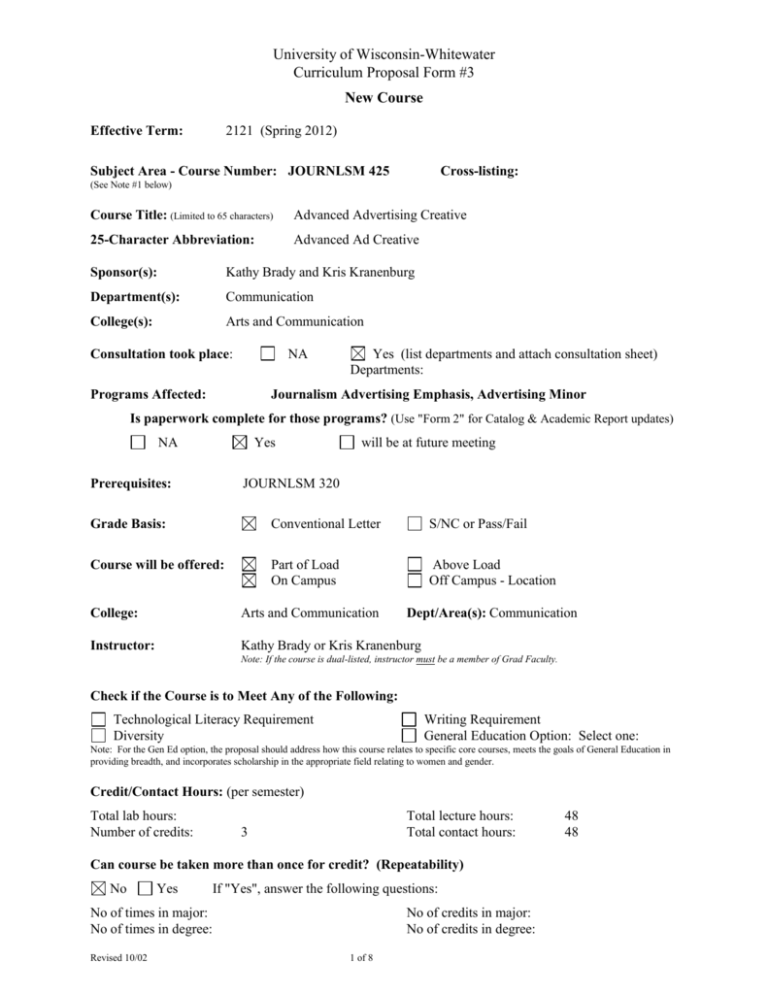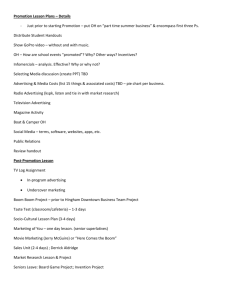New Course - University of Wisconsin Whitewater
advertisement

University of Wisconsin-Whitewater Curriculum Proposal Form #3 New Course Effective Term: 2121 (Spring 2012) Subject Area - Course Number: JOURNLSM 425 Cross-listing: (See Note #1 below) Course Title: (Limited to 65 characters) Advanced Advertising Creative 25-Character Abbreviation: Advanced Ad Creative Sponsor(s): Kathy Brady and Kris Kranenburg Department(s): Communication College(s): Arts and Communication Consultation took place: NA Programs Affected: Yes (list departments and attach consultation sheet) Departments: Journalism Advertising Emphasis, Advertising Minor Is paperwork complete for those programs? (Use "Form 2" for Catalog & Academic Report updates) NA Yes Prerequisites: will be at future meeting JOURNLSM 320 Grade Basis: Conventional Letter S/NC or Pass/Fail Course will be offered: Part of Load On Campus Above Load Off Campus - Location College: Arts and Communication Dept/Area(s): Communication Instructor: Kathy Brady or Kris Kranenburg Note: If the course is dual-listed, instructor must be a member of Grad Faculty. Check if the Course is to Meet Any of the Following: Technological Literacy Requirement Diversity Writing Requirement General Education Option: Select one: Note: For the Gen Ed option, the proposal should address how this course relates to specific core courses, meets the goals of General Education in providing breadth, and incorporates scholarship in the appropriate field relating to women and gender. Credit/Contact Hours: (per semester) Total lab hours: Number of credits: Total lecture hours: Total contact hours: 3 Can course be taken more than once for credit? (Repeatability) No Yes If "Yes", answer the following questions: No of times in major: No of times in degree: Revised 10/02 No of credits in major: No of credits in degree: 1 of 8 48 48 Proposal Information: (Procedures for form #3) Course justification: Our existing advertising classes give students the opportunity to work on a broad range of projects but do not allow them to focus in depth on any one project. As a result, students interested in copywriting and/or layout do not get enough experience revising and resubmitting individual assignments with the ultimate goal of perfection. The Advanced Advertising Creative course will help develop the necessary discipline to accept and incorporate criticism in an ongoing creative development process and will play a vital role in the preparation of a professional portfolio. This course is especially important for students planning to work on the creative side of advertising because it gives them opportunities for hands-on creative work not possible in other classes in the curriculum. Relationship to program assessment objectives: This course is an elective that gives students the opportunity to apply research, theory and critical-thinking skills in the creation of hands-on advertising work. It challenges students to a high level of excellence in the development of their own creative work by requiring personal and peer assessment, ongoing revision of projects, professional-level quality of finished materials, and the ability to present work effectively. The course addresses the ever-changing media marketplace and emphasizes the different styles of writing used in advertising today. Students will consider the diversity of audiences in the preparation of both written and visual information. This course will also help students identify the proper career path and prepare for employment searches after graduation. Advanced Advertising Creative will help students develop intellectual and practical skills as outlined by LEAP: inquiry and analysis, critical and creative thinking, written and oral communication, information literacy, and problem solving. The course accomplishes this by focusing on two LEAP high-impact educational practices. First, the course is writing intensive. By nature, advertising requires students to produce and revise various forms of writing for different audiences. One of the tenets of this course is that students must continue revising each assignment until they attain a standard of excellence on each. Secondly, the course serves as a capstone for our students pursuing careers in the creative realm of advertising, as copywriters or designers, requiring them to create a portfolio of their best work. Budgetary impact: None anticipated. Current faculty have the skills needed to teach the course and it will only be offered every third semester. As a result, the teaching of this course can be managed with the staff already in place and needs no additional funding to make the course operational. Course description: (50 word limit) Students apply copywriting, layout, research, and strategy skills gained in other advertising courses to hands-on development of portfolio-quality creative materials. Projects require strong conceptualization, writing, and presentation skills and the ability to use criticism to improve creative work. Especially helpful for students planning to work in advertising writing or design. If dual listed, list graduate level requirements for the following: 1. Content (e.g., What are additional presentation/project requirements?) 2. Intensity (e.g., How are the processes and standards of evaluation different for graduates and undergraduates? ) 3. Self-Directed (e.g., How are research expectations differ for graduates and undergraduates?) Course objectives and tentative course syllabus: Revised 10/02 2 of 8 See attached syllabus. Bibliography: (Key or essential references only. Normally the bibliography should be no more than one or two pages in length.) Adland: http://adland.tv/ Ads of the World: http://adsoftheworld.com/ Advertising Age: http://www.adage.com Advertising World: http://advertising.utexas.edu/world/ Adweek: http://www.adweek.com Aitchison, J. (1999). Cutting edge advertising: How to create the world’s best for brands in the 21st century. Upper Saddle River, NJ: Prentice Hall. Ask a Copywriting Blog: http://www.askacopywriter.blogspot.com/ Barry, P. (2008). Advanced concept book. New York: Thames and Hudson. Bly, R. W. (2005). The copywriter’s handbook: Step-by-step guide to writing copy that sells. (3rd ed.). New York: Henry Holt. Bendinger, B. (2009). The copy workshop workbook. Chicago: Copy Workshop. Brands of the World: http://www.brandsoftheworld.com/ Brandweek: http://www.brandweek.com/bw/index.jsp ClickZ: http://www.clickz.com Creativity Magazine: http://creativity-online.com Communication Arts: http://www.commarts.com/ CMYK Magazine: http://cmykmag.com/ Direct: http://www.directmag.com DMNews.com: http://www.dmnews.com Felton, G. (2006). Advertising concept and copy. New York: W. W. Norton & Company. Fortini-Campbell, L. (2001). Hitting the sweet spot: How consumer insights can inspire better marketing and advertising. Chicago: Copy Workshop Revised 10/02 3 of 8 Griffin, G. (2010). The creative process illustrated: How advertising's big ideas are born. Cincinnati: HOW Books. Heath, C. and Heath, D. (2008). Made to stick: Why some ideas survive and others die. New York: Random House. LaRocque, P.(2000). Championship writing: 50 ways to improve your writing. Oak Park, IL: Marion Street Press. LaRocque, P. (2003). The book on writing: The ultimate guide to writing well. Oak Park, IL: Marion Street Press. Lewis. H. G. (2000). On the art of writing copy: The best of print, broadcast, internet, direct mail. New York: AMA Publications. Mashable Social Media News: http://mashable.com/ Media Life: http://www.medialifemagazine.com/ Mumaw. S. (2006). Caffeine for the creative mind: 250 exercises to wake up your brain. Cincinnati: F&W. Ogilvy, D. (1985). Ogilvy on Advertising. New York: Random House. Paetro, M. (2010). How to put your book together and get a job in advertising. New York: W. W. Norton & Company. Pricken, M. (2008). Creative advertising. New York: W. W. Norton & Company. Promo: http://promomagazine.com/ Sullivan, L. (2003). “Hey, Whipple, squeeze this”: A guide to creating great ads (2nd ed.). New York: John Wiley & Sons, Inc. Truss, L. (2003). Eats, shoots & leaves: The zero tolerance approach to punctuation. New York: Gotham Books. Vonk, N. and Kestin, J. (2005). Pick me: Breaking into advertising and staying there. Hoboken, NJ: John Wiley & Sons, Inc. The University of Wisconsin-Whitewater is dedicated to a safe, supportive and non-discriminatory learning environment. It is the responsibility of all undergraduate and graduate students to familiarize themselves with University policies regarding Special Accommodations, Academic Misconduct, Religious Beliefs Accommodation, Discrimination and Absence for University Sponsored Events (for details please refer to the Schedule of Classes; the “Rights and Responsibilities” section of the Undergraduate Catalog; the Academic Requirements and Policies and Revised 10/02 4 of 8 the Facilities and Services sections of the Graduate Catalog; and the “Student Academic Disciplinary Procedures (UWS Chapter 14); and the “Student Nonacademic Disciplinary Procedures" (UWS Chapter 17). Course Objectives and tentative course syllabus with mandatory information (paste syllabus below): JOURNALISM 425: ADVANCED ADVERTISING CREATIVE SYLLABUS Instructor(s): Kathy Brady — Office: HE458 — Phone: (262) 472-1726 — Email: bradyk@uww.edu Kris Kranenburg — Office: L2228 — Phone: (262) 472-2876 — Email: kranenbk@uww.edu Required Text: Barry, P. (2008). Advanced Concept Book. New York: Thames and Hudson. Recommended Reading: Advertising World: http://advertising.utexas.edu/world/ Adland: http://adland.tv/ Ads of the World: http://adsoftheworld.com/ Advertising Age: http://www.adage.com Adweek: http://www.adweek.com Brands of the World: http://www.brandsoftheworld.com/ Brandweek: http://www.brandweek.com/bw/index.jsp Creativity Magazine: http://creativity-online.com Communication Arts: http://www.commarts.com/ CMYK Magazine: http://cmykmag.com/ Direct: http://www.directmag.com DMNews.com: http://www.dmnews.com Promo: http://promomagazine.com/ Media Life: http://www.medialifemagazine.com/ Mashable Social Media News: http://mashable.com/ Course Prerequisites: JOURNLSM 320 Course Objectives: Understand concepts and apply theories in the use and presentation of images and information. Work ethically in pursuit of truth, accuracy, fairness and diversity. Think critically, creatively and independently Conduct research, evaluate information, and develop strategy to guide development of concepts and executions Write correctly and clearly in forms and styles appropriate to specific audiences and media Revised 10/02 5 of 8 Critically evaluate your own work and that of others for accuracy and fairness, clarity, appropriate style and grammatical correctness (Based on AEJMC’s student learning outcomes.) Course Description In this course, students will apply the copywriting, layout, research, and strategy skills gained in other advertising courses to hands-on development of portfolio-quality creative materials. Projects require strong concepting, writing, and presentation skills and the ability to use criticism to improve creative work. This course is especially helpful for students planning to work in advertising writing or design and will assist students in the development of portfolio material necessary for pursuing a creative job in advertising. Attendance Policy Attendance is expected at all classes and will be taken regularly, especially when attendance is down. After the first few class periods, an attendance sheet will be passed around. It is your responsibility to sign this sheet. These sheets are how I take attendance and are filed in case of questions. However, I understand we all have illnesses and conflicts we need to deal with. Therefore, you are allowed 3 absences for the semester for any reason. (Contact the Dean of Students if you have a family emergency or extended illness.) For each absence over the 3-class limit, 10 points will be deducted. The University of Wisconsin-Whitewater is dedicated to a safe, supportive and nondiscriminatory learning environment. It is the responsibility of all undergraduate and graduate students to familiarize themselves with University policies regarding Special Accommodations, Academic Misconduct, Religious Beliefs Accommodation, Discrimination and Absence for University Sponsored Events (for details please refer to the Schedule of Classes; the “Rights and Responsibilities” section of the Undergraduate Catalog; the Academic Requirements and Policies and the Facilities and Services sections of the Graduate Catalog; and the “Student Academic Disciplinary Procedures (UWS Chapter 14); and the “Student Nonacademic Disciplinary Procedures" (UWS Chapter 17). Assignments: Projects: Print ad Consumer profile Media writing Radio/TV/New media campaign Nontraditional advertising project Long copy Portfolio – Version 1 Revised 10/02 50 pts 50 pts 100 pts 150 pts 100 pts 150 pts 100 pts 6 of 8 Portfolio — Version 2 2 exams TOTAL 100 pts 200 points 1,000 points Grading Scale: A AB+ B BC+ C CD+ D DF 930 –1000 points 900-929 points 879-899 points 830-878 points 800-829 points 779-799 points 730-778 points 700-729 points 679-699 points 630-678 points 600-629 points 599 points or below COURSE SCHEDULE Week One: Strategy Week Two: Print advertising; Concepts vs. execution Week Three: Copy and visualization; Workshop Week Four: Consumer profile; Workshop Week Five: Feedback session — 3 print-ad campaign Week Six: Media writing Week Seven: New media Week Eight: Campaigns; Workshop Week Nine: Feedback session — Media (radio/TV/new media campaign) Week Ten: Non-traditional advertising Week Eleven: Portfolio; Workshop Week Twelve: Feedback session — Nontraditional project Week Thirteen: Long copy Week Fourteen: Feedback session — Portfolio Revised 10/02 7 of 8 Week Fifteen: Feedback session — Portfolio Week Sixteen: Final exam Revised 10/02 8 of 8






